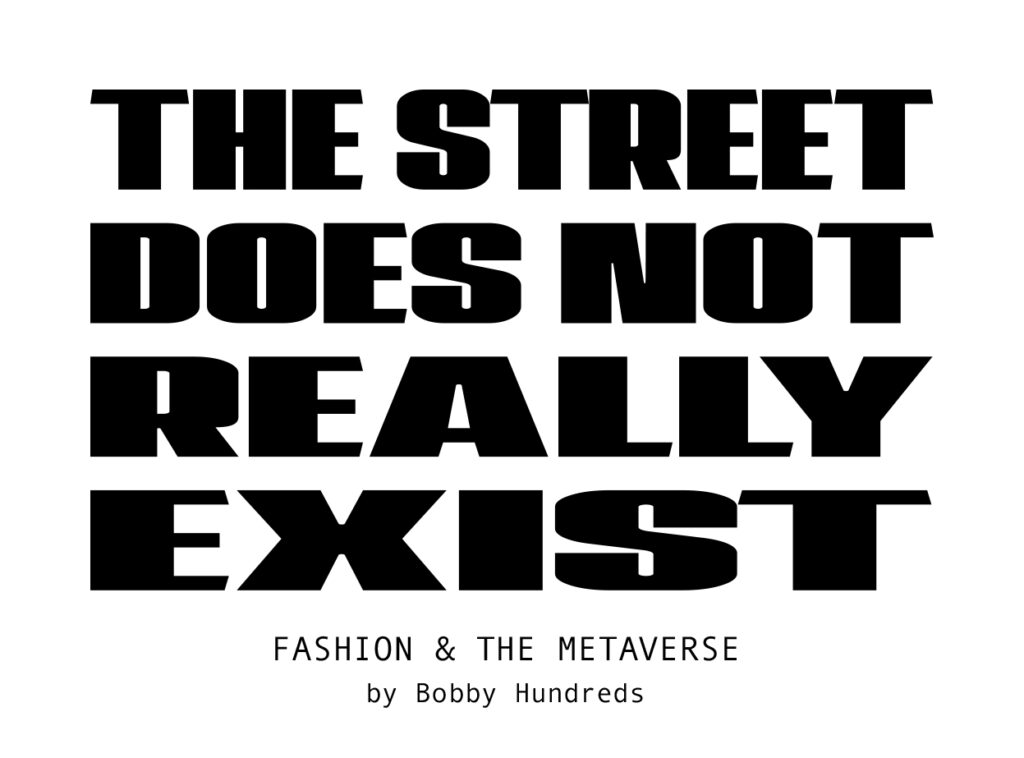
If you’ve watched the Woodstock ’99 doc, you know it’s less an analysis of music festivals as it is about displaced male rage and the anxious social climate as we teetered on the new millennium. 1999 was an awkward time for the world; it very much felt like we were neither here nor there, nervous about what Y2K might bring (or take). Or maybe that was just me, as I turned 19 in the year 1999. Not quite ready for the responsibilities of my 20s yet feeling distant and removed from my youth.
That same year, a movie called The Matrix premiered in theaters, architecting a cyberpunk universe around virtual reality and a classical hero named Neo. Keanu Reeves plays an average dude who jacks into the simulation and is reborn a Christ figure. Once he acknowledges his departure from the physical world and embraces his standing in the green grid of 1s and 0s, the possibilities are limitless. At the time, with the dawn of the Internet, many young people shared Neo’s enthusiasm and ambition around this brave new world. We were graduating from AOL chatrooms and finding each other on ICQ. And then, a website called Blogger launched in the late summer of ‘99 and changed everything. Once again, maybe the entire planet didn’t feel the ground shake, but I certainly did.
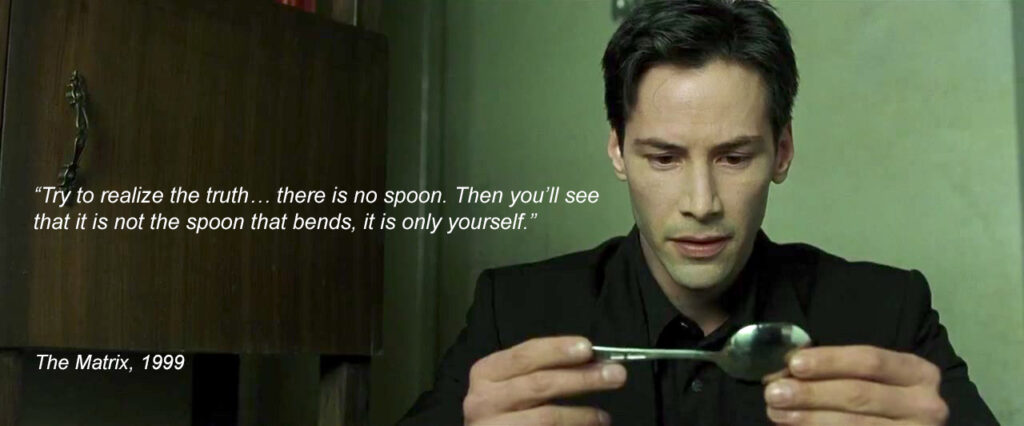
“Blog” was short for “web log” and it was a means to broadcast loud messages and connect with a borderless audience. Blogger addressed a lot of the problems that plagued traditional media. For one, it was relatively free and decentralized (not governed by the Big 6 media strongholds). Blogging was also efficient, immediate, and lowered the barrier of entry for desktop publishers. After years of cutting, gluing, and pasting physical ‘zines at Kinko’s to distribute to 100 punks at my local music venue, I could now blog to thousands, and then millions, of strangers from Detroit to Indonesia. In fact, I saw so much inherent value and opportunity in Blogging, that when Ben and I started The Hundreds four years later, we framed our clothing brand with the technology. Throughout history, fashion had been storytold exclusively through product and advertising. Blogging (and its later iteration, social media) changed that, erasing the line between logos and lifestyle, design and narrative.
We were one of the first clothing companies in the world to capitalize on the power of a dynamic web. In the early 2000s, a startup T-shirt label from LA called thehundreds.com was attracting as many eyeballs as a Gucci HTML page. Most fashion designers used their websites to publicize a CONTACT US button or static lookbook. They rarely updated their dotcoms. Meanwhile, you could refresh The Hundreds’ front page 2-3 a day and be surprised with fresh material. The hyperactivity of our blog communicated streetwear’s galvanic energy to an impressionable new customer. This first generation of the Internet (Web 1) also granted independent brands the freedom and power to circumnavigate gatekeepers and media middlemen. In those days, it cost $10,000 USD to take out an ad in Complex Magazine. Through Blogs, upstart designers like The Hundreds without any connections, clout, or money could now tell their story in their own words and meet customers on their own terms*.
*I should clarify that the technology wasn’t the key component that brought The Hundreds to the world. For the Blog to work, it required a writer and a photographer and most importantly, someone who saw the benefits of tending to a community and cared enough to do it. Most technology can’t replace the creator’s ideas or intent. However, technology can accelerate an artist’s vision.
For the next ten years, Blogging and social media amplified and expedited our mission in streetwear. Then the rest of the brands caught up, thanks to centralized Web 2 applications like WordPress and Instagram. In the decade and a half since, this marriage of Blog and Brand has become Business and revolutionized how companies and commerce perform. Yet, there has been relatively low innovation otherwise with regards to both fashion and technology. On the tech side, the platforms swap out and e-commerce gets more sophisticated, but we’ve become complacent with the system and stagnant with the breakthroughs. We’ve acquiesced that this is the Internet in its final form when the truth is that Web 3 is just beginning. The next evolution of the Internet – NFTs, blockchain – is inspiring and stimulating me in a way I haven’t felt since Blogger launched twenty years ago. And a lot of that excitement has to do with, once again, a revised approach to fashion.
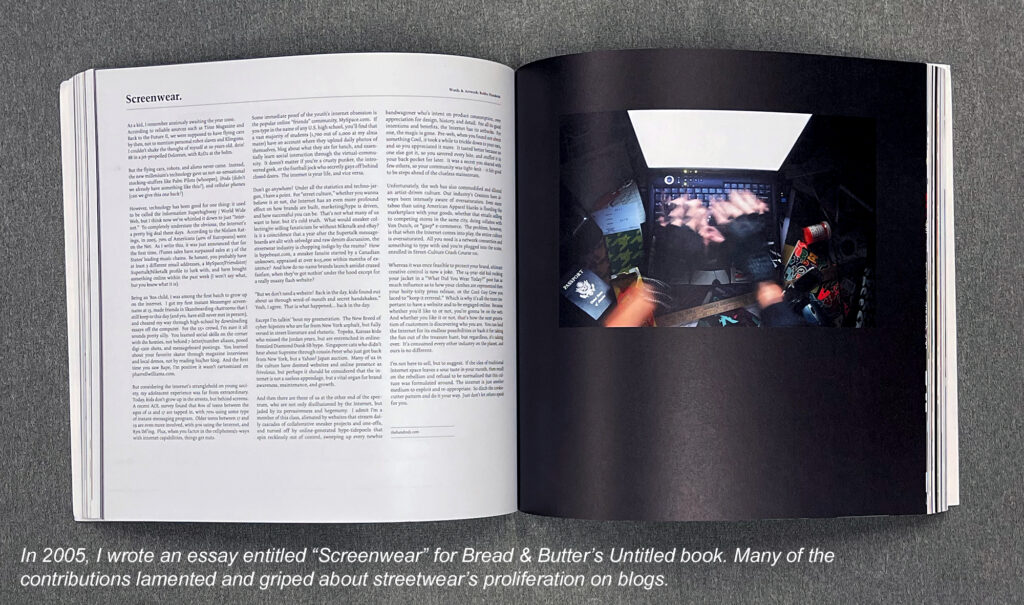
THE METAVERSE
Although the concept has been floating around for some time, the science fiction writer Neal Stephenson coined the term “Metaverse” in his 1992 novel, Snow Crash.
“Hiro’s not actually here at all. He’s in a computer-generated universe that his computer is drawing onto his goggles and pumping into his earphones. In the lingo, this imaginary place is known as the Metaverse.”
Ever since, futurists and blockbuster movies alike have referenced the term for a reality that is tethered to both a digital and physical experience. In The Matrix, Neo is immersed in a fantasy world of red dresses and bending spoons while physically wired into a post-apocalyptic dentist’s chair. The metaverse is different from solely virtual reality and it’s not necessarily a game or an Internet thing. It’s this idea that there is a universe beyond (aka “meta”) the one we’ve known and participated in. In this metaverse, rules are being written, societies are being built, and new realities constructed.
“When Hiro goes into the Metaverse and looks down the Street and sees buildings and electric signs stretching off into the darkness, disappearing over the curve of the globe, he is actually staring at the graphic representations—the user interfaces—of a myriad different pieces of software that have been engineered by major corporations.”
The working theory is that we will build atop the tech to mirror our lives here in the physical world. There will be no hard line drawn between this reality and the next. One day it will hit us that we have already been living a full metaverse existence, one where our physical and digital lives are inextricable and unmanageable without the other.
For many of us, that awakening was the pandemic. It wasn’t just food delivery apps and streaming services that made the lockdown transition more seamless than it would have been mere years ago. While Zooms handily replaced meetings, our social relationships stayed intact because our friendships are hoisted up by digital rebar. There are many friends I haven’t seen in five months, ten years, or decades that I maintain an unbroken rapport with virtually. Some of these people, I’ve never met in person at all! And yet, we’ve shared deep conversations in forums, worked together over DMs, and built memories in groupchats like any other IRL relationship. It wasn’t long ago that we defined friends as online or “In Real Life.” Today, that distinction is evaporating.*
*Spike Jonze’s 2013 movie “Her,” in which Joaquin Phoenix’s character builds a romantic connection with an AI that he’ll never encounter in his physical life, doesn’t seem so outlandish in the year 2021.
Not only is our social life already grounded in the metaverse, so is much of our identity. Last year, we used filters to alter our appearances, posted black squares and blue stripes to declare our political stances, and farmed carrots in Animal Crossing to feel productive and purposeful in a flat and motionless season (all while binging Tiger King, prostrate on the couch in tie-dyed sweatpants by a DTC brand). In the metaverse, we can be whomever we want, unfettered by physical constraints, geography, even race, class, and gender. Video games allow unlikely athletes to be e-sports champions. Editing apps bless those with beauty. In Ernest Cline’s Ready Player One, Aech’s avatar in the OASIS is a white heterosexual male. In the physical world, Aech’s name is Helen Harris, a Black lesbian. As the world around us decays and grows more inhospitable – whether due to climate change, pandemics, political differences, or social collapse, the metaverse becomes more enticing as a refuge*.
*The thought leader Balaji Srinivasan talks about pseudonymity in the metaverse (the ability to commandeer multiple identities and profiles) as a foil to cancel culture. Whereby cancelling one of your pseudonyms doesn’t take down your entirety. You can simply pivot to another avatar and continue your life and livelihood.
If you can accept that we’re already steeped in the metaverse, that our bodies remain in the physical world while our brains are increasingly minding a digital life (are you having trouble concentrating on your dinner date, anxious to return to a developing conversation or situation on your phone?), then it only follows that there needs to be some type of protocol to establish ownership, goods, and property in cyberspace. The apt currency to trade in this galaxy of virtual worlds are crypto coins like Bitcoin, Cardano, and Doge. My sons call Ethereum my Star Wars money and it certainly sounds like something Watto barters for on Mos Espa. Planet Earth has been slow and cautious in accepting Jedi cash, so in the metaverse, NFTs are commodities and utilities to spend cryptocurrency and accrue value with digital investments. Even my grade-school sons appreciate how a fist full of Robux (Roblox) or V-Bucks (Fortnite) enhances their life over a $20 USD bill at Target.
THE ENVIRONMENT
Speaking of which, we should probably start by discussing why humans need to own anything at all. At some point, we went from cavemen with no possessions, to hunter-gatherers, to hoarders stashing sneakers and rare vinyl. We own some things for utility and survival. Then there are those items that are imbued with sentiment and fill an emotional need. We also own things to decorate our lives, to make our environment more tolerable or beautiful. And we hold onto much of our possessions because they express who we are. In his book Subculture*, Dick Hebdige talks about how punks upset the wardrobe with anti-establishment symbols** to fight the hegemony.
* If there was a bible upon which The Hundreds is spiritualized upon, it’s probably Subculture by Dick Hebdige. Although written in 1979, I didn’t discover the book until – you guessed it – 1999!
** “There was a chaos of quiffs and leather jackets, brothel creepers and winkle pickers, plimsolls and paka macs, moddy crops and skinhead strides, drainpipes and vivid socks, bum freezers and bovver boots – all kept ‘in place’ and ‘out of time’ by the spectacular adhesives: the safety pins and plastic clothes pegs, the bondage straps and bits of string which attracted so much horrified and fascinated attention.”
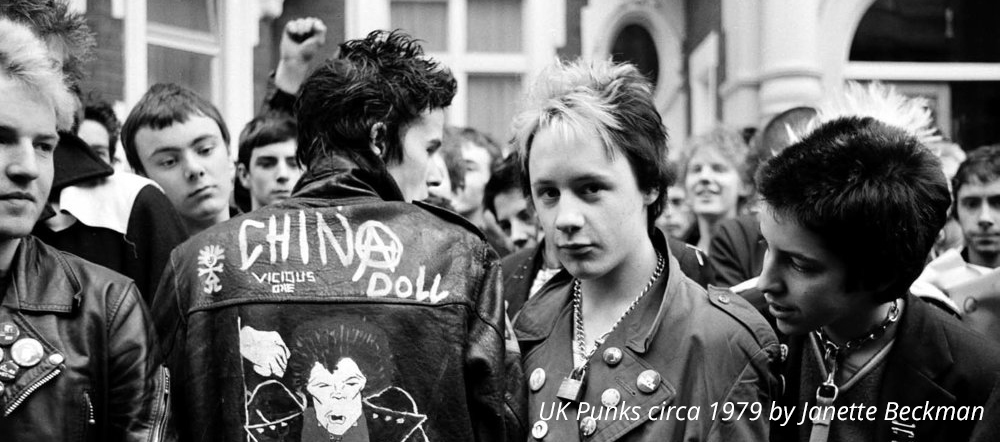
It’s hard to judge which pieces of property are essential. How do you weigh the necessity of an heirloom against an appliance? But you can debate their costs and detriments, especially when it comes to the environment.
Look around. Chances are that you have too much stuff. I’ve spent the last two weekends editing my closet of clutter and feel like I’ve barely made a dent. It’s a problem that weighs on my mind, considering the type of work that I do. I run a streetwear clothing brand here in Los Angeles. We’ve generated truckloads of T-shirts, denim, baseball caps, and jackets. And although we’re doing what we can to re-purpose apparel via a vintage program (Greatest Hits), incorporate recycled water and cottons in production, and employ sustainable materials, there is no doubt that we contribute to gratuitous waste. The sustainability question is a real thorn for the fashion industry because if you only look at the utility aspect of apparel – to protect us from the elements and insulate us from exposure – then we have enough clothing to last us a lifetime. No matter how environmentally conscious brands are with their manufacturing, the very existence of new fashion is problematic in an unforgiving, black-and-white world.
“Many are making it look as if the fashion industry are starting to take responsibility, by spending fantasy amounts on campaigns where they portray themselves as ‘sustainable,’ ‘ethical,’ ‘green,’ ‘climate neutral’ and ‘fair.’ But let’s be clear: This is almost never anything but pure green washing. You cannot mass produce fashion or consume ‘sustainably’ as the world is shaped today. That is one of the many reasons why we will need a system change.”
– Greta Thunberg, climate activist, Vogue Scandinavia, August 8, 2021

The type of clothing I design and make is especially prickly because it’s artistically, socially, and identity driven. I believe in the virtues of Art and Design and how fashion can make people feel happy, special, and part of a community. But, is there a way to accomplish these functions without taxing the environment and exacerbating the climate crisis?
This is an awkward re-entry point for the metaverse conversation as the computers that house simulated environments and mine cryptocurrency transactions devour energy at an alarming rate. Although bitcoin mining is starting to clean up its act and Ethereum is transitioning the blockchain to a proof-of-stake system, even Elon Musk rescinded his crypto co-sign earlier this year because of its environmental impact. Bitcoin’s network, according to Fortune, “uses more power per year than Pakistan or the United Arab Emirates.” Of course, there is the rebuttal that any and all computer activity harms the planet. “The average impact of a user on Instagram is 18.6 gEqCO2 / day, the equivalent of 166 meters traveled by a light vehicle.” And back to fashion, making one T-shirt eats “up to 120 liters of water per wear, and contributes 0.01 kilogram of carbon dioxide per wear, just from dyeing alone.” This, before you factor in the energy costs to print, the chemicals in the ink, and shipping and freighting these T-shirts between factories and to the end-consumer. Oh, and then there’s what happens to the T-shirt once it dies….
Since we’re ruminating on a fantasy world, let’s indulge a bit and imagine a future where crypto carries through with its promise to run cleaner. The metaverse could solve many of fashion’s environmental issues and maybe it already does. Consider the blue Verified check, a badge of distinction. The real-world equivalent might be something akin to a friends-and-family pair of AF1s, a Rolex watch, or a medal of honor. In 1974, Umberto Eco wrote, “not only the expressly intended communicative object . . . but every object may be viewed . . . as a sign.” Donning a graphical logo in your profile picture is not unlike hanging it on your back. They are both acts of affinity, announcing your association with a lifestyle to your friend group. Except one of these things projects and the other pollutes.
A “GOT ‘EM” screen-grab off Nike’s SNKRS app holds as much weight as wearing the sought-after shoes to a party. Most of us who are fashion-aware could tell you all about Kanye’s GAP “round jacket,” the levitating puffy coat having flooded our feed enough times to commit to memory. Yet, we’ve never seen one in “real life,” considering the actual jackets aren’t even made yet. Meanwhile, the coveted pieces are just as ubiquitous as illuminated pixels as they would be stretched across reams of nylon. Billboard-sized projections of the jacket are currently blasted onto the sides of buildings in New York, Chicago, and Los Angeles.
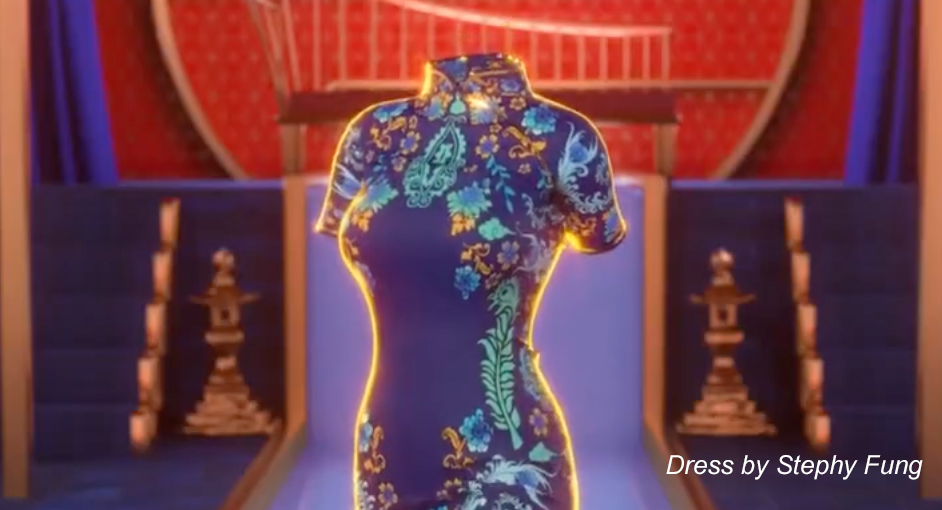
In a more direct and literal sense, brands are already designing clothing for the metaverse. The social status aspect of fashion is on the move from cotton to pixels. Video games have been doing this for years. My children are well-practiced in shopping for digital outfits in games like Fortnite, more conscious of their Valorant skins than the types of T-shirts they wear on the playground. Shops like BNV.me, artists like Stephy Fung, and sneaker brands like RTFKT are creating and selling metaverse fashion that run parallel to what you might find stocked at Dover Street Market. Virgil Abloh recently hinted that he is working on dressing you for the next world with the help of venture capitalist and essayist Matthew Ball. It’s only a matter of months before the social apps flip the switch on for NFTs. Just like you can pull a Disney princess filter over your face in Stories or Snapchat, you’ll be able to wear your favorite digital sweatshirt on TikTok. There will be an IG tab to showcase all the NFT art you’ve collected with the capabilities to trade them on the blockchain (NFT art can stand for everything from a motion graphic to a scan of an oil painting to a pair of Bode shorts).
THE FUTURE OF FASHION
Having said that, on the topic of metaverse clothing, what excites me the most is not the mirroring of physical garments in the virtual world. It’s thinking beyond the confines and constructs of logistics and tradition and norms. This is where I envision NFTs and the metaverse really changing the game. There are two prongs that will drive the future of fashion:
1) the reimagining of design and
2) the rethinking of brand and business
For as long as I can remember, I’ve kept a copy of the Codex Seraphinianus on my desk. Published in 1981, the Codex is a meticulously detailed encyclopedia of a fantasy world, illustrated and told by the artist Luigi Serafini. Included are colorful drawings of bizarre food eaten in this imaginary space, wedged between chapters of made-up ecosystems and fabricated science. Even the text is comprised of a fake language that Serafini distills down to an alphabet and vocabulary in the appendix. While the creatures and customs are reminiscent of our world, Serafini designs the plants and chemistry beyond the scope of our earthly limitations. In the fashion chapter, the garments could dress the cast of the Hunger Games or Alice in Wonderland. Flashlights project out from the chest, umbrellas are worn as hats, and shirt sleeves loop infinitely into themselves.
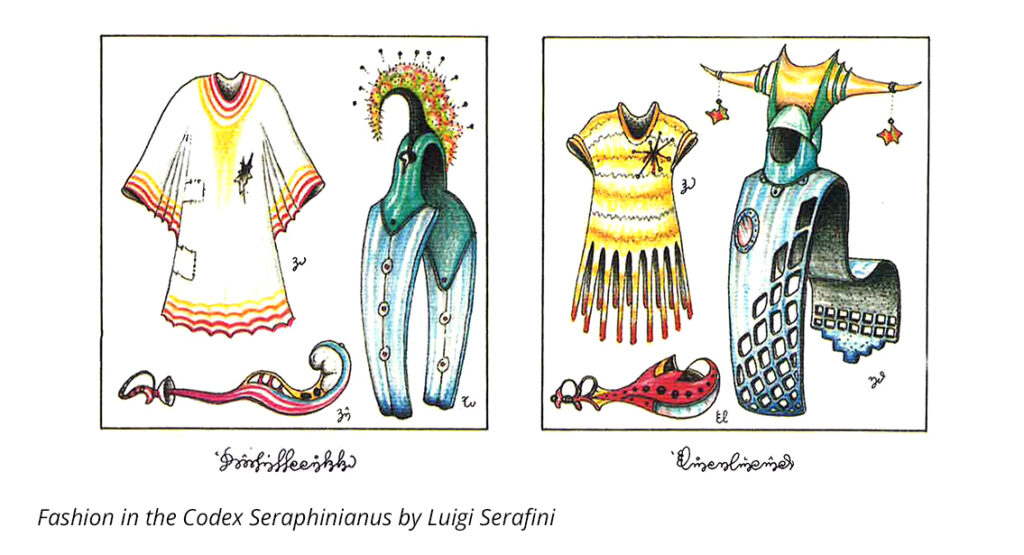
While fashion has been pinched and pulled for centuries, the useful innovation has stayed within the parameters of human anatomy, legal and ethical boundaries, and the laws of physics. In the metaverse, our avatars don’t have to play by any of these rules (Note: In Snow Crash, Stephenson stipulates that, “your avatar can’t be any taller than you are. This is to prevent people from walking around a mile high”). Not only can we identify with the gender and weight we feel most comfortable with, but we can also be cartoon trees, bored apes, or a foggy orb wrapped in bacon. If one of our pseudonyms is a purple duck, then physical-world shoe design won’t accommodate our webbed feet. A COVID face mask won’t fit our wide bill. And do pants go over or under our feathery tail? This sounds silly, but you can see how traditional fashion can quickly fall obsolete when the template for design centers around a slender, proportionate European male or female with two arms and legs. If you add a seventh arm or a second head, how does that impact the garment’s silhouette, where to draw emphasis, and the way the fabric drapes? Do you need to wear shoes or belts in the metaverse if gravity doesn’t apply? Do you need clothes at all if there are different thresholds of nudity? What if you aren’t a corporeal being?
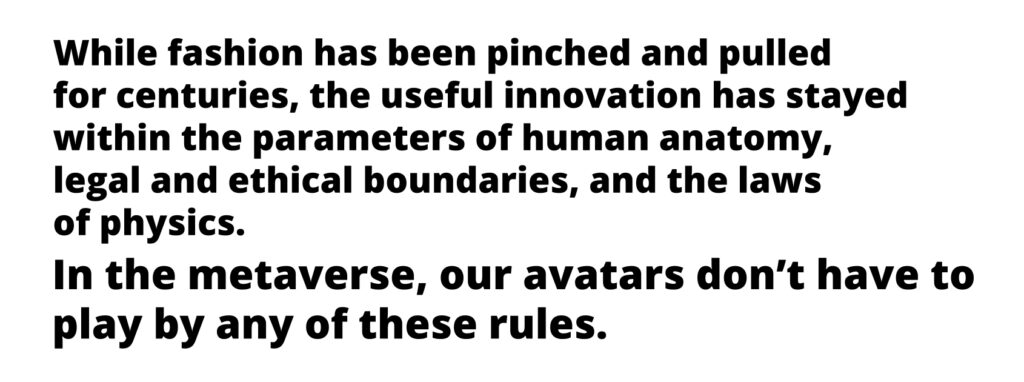
Because exposure and weather are less of a dire concern for clothing in the metaverse, there is an accent on the social function of apparel and accessories. On the other side of the screen, fashion will be more about identity, tribalism, status, and self-expression than ever before. The difference is that those statements won’t be relegated to a T-shirt graphic, a red hat, or a pin on a lapel. Like a Plumbob in a Sims game, that signifier may come in an oscillating pink diamond hanging over your head. Fashion doesn’t have to just be dresses and jackets anymore. Fashion can be polka-dotted skin, 37 rabbits circling you like a hula hoop, or a liquid sweater that’s 11 miles wide.
Fashion can be a square NFT in your avatar.
THE FUTURE OF BUSINESS
While we’re rethinking fashion design, we should also take another look at the business behind it. As I write this, I’m wearing a pair of Brazil Dunks. The Nike swoosh is one of the rare logos I wear like a uniform, even though I am not friends with the founders or get paid by the company to promote for them. I believe that Nike executes superior design and aligns the best partnerships. Yet, my unquestioned loyalty to the swoosh sometimes makes me think back to wearing large skate logos on oversized T-shirts as a teenager.
“You look like a walking billboard,” my mom would remark. “Why do you want to advertise for some corporation that doesn’t care about you?”
Of course, the answer was nothing more than, “Because it’s cool, mom. You’ll never understand!” But the further explanation was that I felt like I was a part of a lifestyle and subculture by wearing that logo. A “Think” tag or “New Deal” graphic was a quick ID on a core, authentic skater. With my brand, The Hundreds, we’ve also sold a similar meaning behind our logo and mascot, Adam Bomb. Young people from around the world have proudly sported the cartoon to exhibit their ties to streetwear, love for Los Angeles culture, or empathy with The Hundreds’ point-of-view.
Beyond the usefulness or quality of a product, people commit to brand names because of 3 things:
1) Identity,
2) Community,
3) Sense of Ownership.
Yet, while wearing Nike tells the world something about my identity, while dressing in The Hundreds offers our customers a community, neither of us retain any skin in the game. That disparity in ownership betrays a big disconnect in the brand-consumer relationship, one that until now has been dismissed because there was nothing to be done to fix it.
When I started delving into NFTs back in December, what most intrigued me was the postulate that social media companies have made 100% of the revenue off the creative content that its users publish on their platforms. This explains why these corporations have become the biggest — and their founders the wealthiest — in the world. Twitter generated $3.7 billion USD revenue in 2020, an 8.8% increase year over year. Meanwhile, Facebook’s advertising revenue was $84.2 Billion USD (they’ve more than doubled since 2017). Everyday creators know their work has value. They’ve just been convinced over the last decade that there isn’t a market for their art or ideas and that the clout associated with posting free content is just as valuable as currency.*
*Plus, there just weren’t many viable solutions on centralized platforms to be compensated for content (subscription sites like OnlyFans have experienced rapid growth in response).
Designers and clothing companies also hold a disproportionate relationship with their patrons in that the customers advertise brands without being compensated equitably. Travis Scott catches a check from Nike because the culture deems him an influential person. But, every time I wear the Check over Stripes, I’m a Nike influencer too. In fact, anyone who has a following – whether you have 600 people on TikTok or 3 people who admire your shoes at the barbershop – is an influencer. Nike shouldn’t pay us equal royalties for helping them move product (Travis sells millions of sneakers while I’ve maybe convinced my dad to grab a pair of Monarchs on sale), but if there was a device that could measure an influencer’s impact and grant them some of the upside in a brand’s success, then everybody wins. The consumer is incentivized to wear the company’s product because they now hold all 3 cards: Identity, Community, and Ownership. And the brand gains greater visibility in the marketplace.
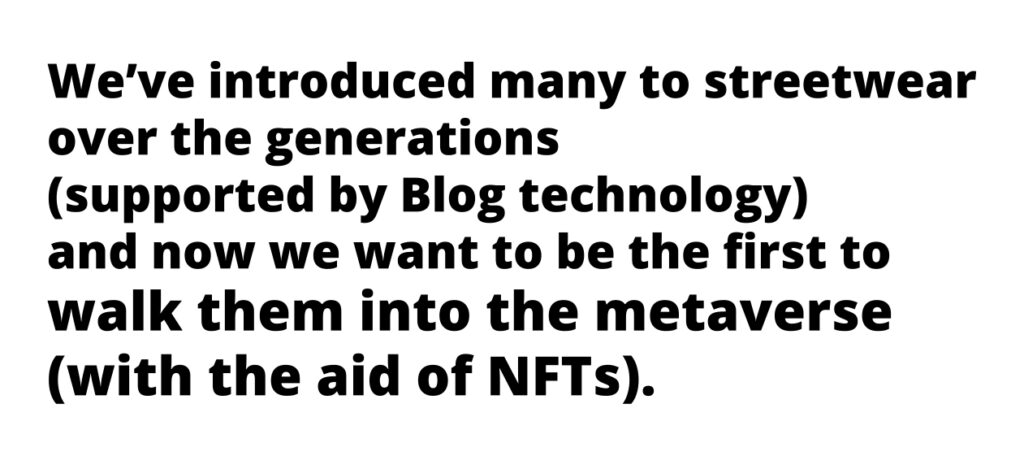
ADAM BOMB SQUAD
Along with Blogger and the Matrix, there was one other seismic development in 1999: Napster. The peer-to-peer MP3 sharing software broke the music industry, which up until that point, bottled music in $12.99 plastic discs, distributed from behind a monolith of big box retail. Once the floodgates torrented open, the fans reclaimed the power in the label-listener balance. They dictated how music should be consumed: quality singles, instead of paying for 11 shitty tracks. Music became more discoverable and shareable. Napster’s greatest legacy, however, was in taking music online.
Whenever friends of mine have trouble grasping the intangible nature of NFTs, I point to music. As a borderline boomer, I still have trouble discarding my CD wallets and cartons of cassettes, even though there’s no stereo in my car or boombox at home to play them. I’m still emotionally bound to these jewel cases and liner notes, but it’s time that I accept that music has been invisible for twenty years. We don’t even store files anymore, we stream sounds off a cloud, whatever that means. Napster was instrumental in this paradigm shift – in how the business around music is conducted, but also in how music is received and enjoyed.

In the next few weeks, The Hundreds will be unleashing an NFT project titled Adam Bomb Squad, comprised of unique, 1-of-1 jpegs of characters. The bombs will only be available for a short window of time before what doesn’t sell “blows up.” There have been hundreds, if not thousands of NFT collections minted recently, inspired by the very first NFT, Larva Labs’ CryptoPunks. Some of the more popular “avatar” collectibles would be the Bored Ape Yacht Club, ArtBlocks, Cool Cats, Glue Factory Horses, and the Vogu Collective. Adam Bomb Squad shares a lot of the same principles as the other sets. Think of these NFTs as sports cards or sneakers with built-in rarities (a specific colorway, a special background) and the ability to buy, sell, and trade the bombs on the secondary market.
However, our project is different from the rest on multiple levels. First, it tells the 18-year-old story of The Hundreds. While every other NFT collectible is setting up a new universe, ours recalls a deeply ingrained history that has intersected with our community throughout their lives. Every single bomb and background pattern is pulled from a season between the years 2003 and 2021, corresponding with milestones and memories that our customers have cherished along the way.
As is customary, we will be anointing NFT holders with perks like exclusive merchandise and early links to drops. Our dreams are outrunning the infrastructure, but a major unlock with these NFTs will be in resolving that outstanding Ownership piece in promoting a brand. We are working on technology to allow Adam Bomb Squad NFT holders to 1) buy The Hundreds clothing featuring their bomb, and 2) be rewarded for the sales on the clothing to others. We want The Hundreds to win, but there’s no reason why our community shouldn’t also partake in the upside.
The first stage of Adam Bomb Squad begins as a digital mirroring of streetwear. Our community will pick up these JPEGs the way they would collect T-shirts. They’ll wear them as their avatars. They’ll deep-dive into the rarities and stories. The long-term goal, however, is that Adam Bomb Squad will institute a new way of conducting and consuming brands – streetwear, fashion, and beyond.
Like Napster changed how we engage with music, our mission is to onboard new users to the blockchain and NFTs and equip them for a future in the simulation. We’ve introduced many to streetwear over the generations (supported by Blog technology) and now we want to be the first to walk them into the metaverse (with the aid of NFTs). It’s not uncommon for fans to approach me in public and profess how they grew up reading thehundreds.com or discovered sneakers and Supreme because of The Hundreds. Years from now, I look forward to hearing, “You were the first NFT I owned” or even better, “You opened my eyes to the metaverse.”
SYSTEM CHANGE
In Snow Crash, Neal Stephenson’s metaverse is called The Street: “a grand boulevard going all the way around the equator of a black sphere with a radius… considerably bigger than Earth.” The author later clarifies, “the Street does not really exist—it’s just a computer-graphics protocol written down on a piece of paper somewhere—none of these things is being physically built.”
The world I come from, Streetwear, also traces its origins to a hypothetical street. Although we dawdled around the Lower East Side and lined up on Harajuku, even though we hang our hat(s) on the Rosewood corner of LA’s Fairfax District, the “street” in “streetwear” is code for the cultures and subcultures that fostered us. The “street” can take the form of a BMX track, a sunset wave, or a sneakerhead message board.
Before COVID took hold, there was a lot of discourse around the state of streetwear in end-of-decade editorial. The 2010s had witnessed an underground fashion movement seize the mainstream spotlight. Streetwear was Everywear: on everyone and everywhere. Louis Vuitton’s Virgil Abloh predicted in a Dazed interview that the party wouldn’t last: “Its time will be up. In my mind, how many more t-shirts can we own, how many more hoodies, how many sneakers?”
I kinda love the narrative that the first NFTs were Larva Labs’ CryptoPunks because the original UK punks circa 1979 also challenged and reshaped fashion’s definition. Eventually, punk style became too popular and played out, just like streetwear’s overexposure. If Hebdige were to concur with Virgil and re-write Subculture today, he’d suggest that it’s time to offer streetwear new meaning.
“Thus, as soon as the original innovations which signify ‘subculture’ are translated into commodities and made generally available, they become ‘frozen’. Once removed from their private contexts by the small entrepreneurs and big fashion interests who produce them on a mass scale, they become codified, made comprehensible, rendered at once public property and profitable merchandise.
Youth cultural styles may begin by issuing symbolic challenges, but they must inevitably end by establishing new sets of conventions; by creating new commodities, new industries or rejuvenating old ones.”

Greta Thunberg did call for a system change…
A couple weeks before Virgil’s quote in Dazed, I also proclaimed that streetwear was dead, but in the sense that it’s constantly culminating and renewing: “The streetwear generation is about regeneration.” The takeaway from this essay echoed my memoir, This Is Not a T-Shirt. Streetwear is boundless because the ethos exists beyond the clothing. It’s beyond the pavement and beyond… the physical. All things considered, at this juncture, doesn’t it make the most sense for streetwear to dress the metaverse?
“Streetwear transcends dress and music, just like rock n’ roll set the philosophical tone for an era. Streetwear defined a generational attitude toward art and commerce, brand-building, and financial autonomy. It was like punk, but about selling. It was like business, but not about selling out.
‘Streetwear.’ Over the next ten years, perhaps we’ll call hoodies and hats something else, because ‘streetwear’ will be applied to tech…”
Is Metawear too… meta?
—X—
If you are confused about NFTs and want to start at the beginning, first off, understand that we’re all wondering. That’s the point. We’re working together to piece the definition, so don’t trust anyone who claims to have a solid grasp of the subject matter. In February, I wrote about as much as I understood on NFTs – at the time – HERE.
Join The Hundreds’ Discord and follow our socials (@thehundreds) for updates on Adam Bomb Squad.
